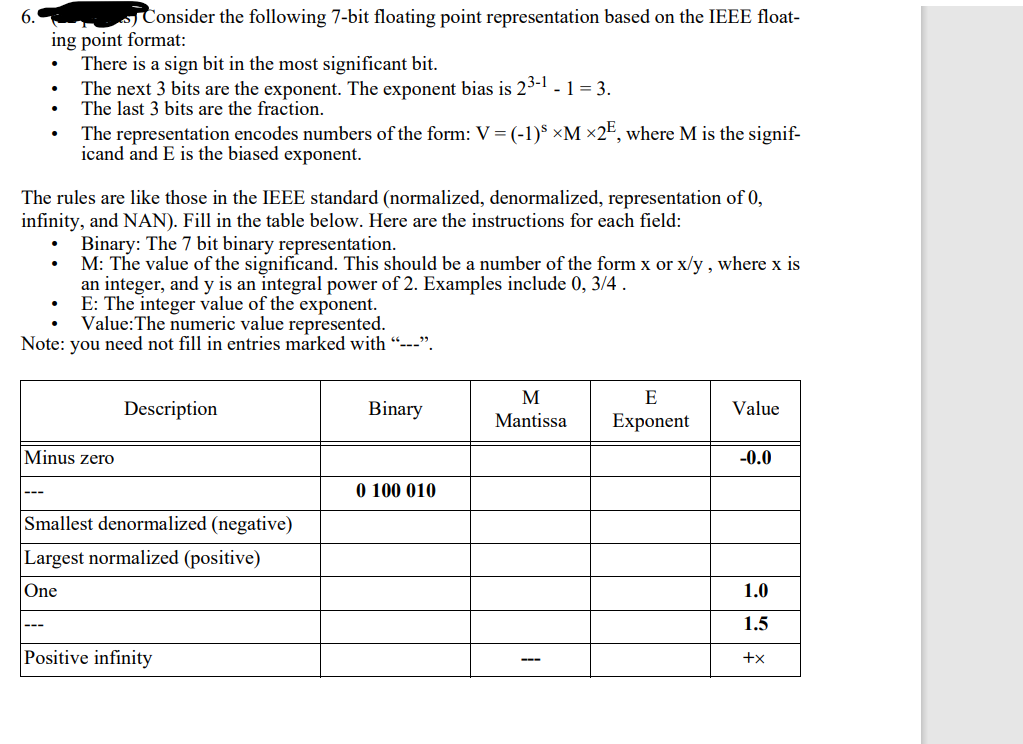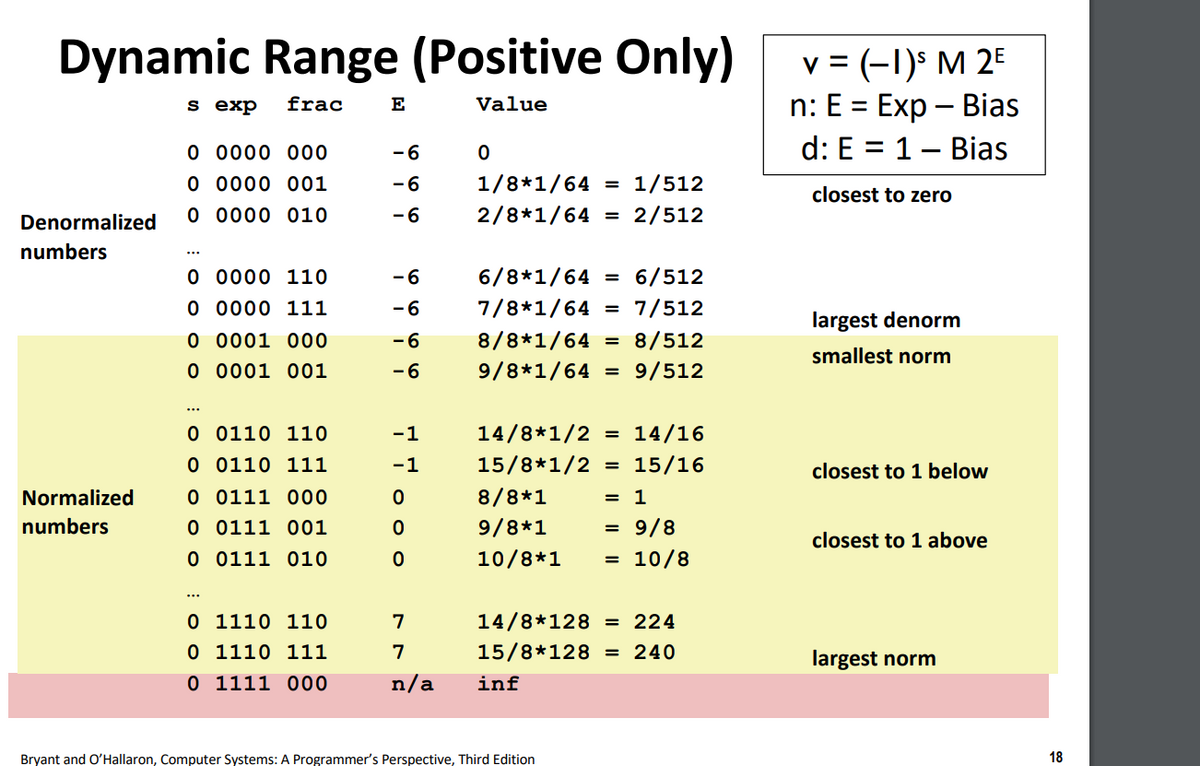ing point format: • There is a sign bit in the most significant bit. • The next 3 bits are the exponent. The exponent bias is 23-1 - 1 = 3. The last 3 bits are the fraction. • The representation encodes numbers of the form: V = (-1)³ ×M×2E, where M is the signif- icand and E is the biased exponent. The rules are like those in the IEEE standard (normalized, denormalized, representation of 0, infinity, and NAN). Fill in the table below. Here are the instructions for each field: Binary: The 7 bit binary representation. M: The value of the significand. This should be a number of the form x or x/y, where x is an integer, and y is an integral power of 2. Examples include 0, 3/4. E: The integer value of the exponent. Value: The numeric value represented. Note: you need not fill in entries marked with _". Minus zero Description Smallest denormalized (negative) Largest normalized (positive) One Positive infinity Binary 0 100 010 M Mantissa --- E Exponent Value -0.0 1.0 1.5 +x
ing point format: • There is a sign bit in the most significant bit. • The next 3 bits are the exponent. The exponent bias is 23-1 - 1 = 3. The last 3 bits are the fraction. • The representation encodes numbers of the form: V = (-1)³ ×M×2E, where M is the signif- icand and E is the biased exponent. The rules are like those in the IEEE standard (normalized, denormalized, representation of 0, infinity, and NAN). Fill in the table below. Here are the instructions for each field: Binary: The 7 bit binary representation. M: The value of the significand. This should be a number of the form x or x/y, where x is an integer, and y is an integral power of 2. Examples include 0, 3/4. E: The integer value of the exponent. Value: The numeric value represented. Note: you need not fill in entries marked with _". Minus zero Description Smallest denormalized (negative) Largest normalized (positive) One Positive infinity Binary 0 100 010 M Mantissa --- E Exponent Value -0.0 1.0 1.5 +x
Database System Concepts
7th Edition
ISBN:9780078022159
Author:Abraham Silberschatz Professor, Henry F. Korth, S. Sudarshan
Publisher:Abraham Silberschatz Professor, Henry F. Korth, S. Sudarshan
Chapter1: Introduction
Section: Chapter Questions
Problem 1PE
Related questions
Question
please full file 6.png this table after make table put right answers in it here is refrence of my lecture note in 18.png this is not graded assigmnet this is paractice test question

Transcribed Image Text:6.
Consider the following 7-bit floating point representation based on the IEEE float-
ing point format:
There is a sign bit in the most significant bit.
The next 3 bits are the exponent. The exponent bias is 23-1 -1 = 3.
The last 3 bits are the fraction.
The rules are like those in the IEEE standard (normalized, denormalized, representation of 0,
infinity, and NAN). Fill in the table below. Here are the instructions for each field:
Binary: The 7 bit binary representation.
M: The value of the significand. This should be a number of the form x or x/y, where x is
an integer, and y is an integral power of 2. Examples include 0, 3/4 .
E: The integer value of the exponent.
Value: The numeric value represented.
Note: you need not fill in entries marked with "---".
---
The representation encodes numbers of the form: V = (-1)³ ×M×2E, where M is the signif-
icand and E is the biased exponent.
•
Minus zero
---
Description
Smallest denormalized (negative)
Largest normalized (positive)
One
Positive infinity
Binary
0 100 010
M
Mantissa
E
Exponent
Value
-0.0
1.0
1.5
+x

Transcribed Image Text:Dynamic Range (Positive Only)
s exp frac
Value
Denormalized
numbers
Normalized
numbers
0 0000 000
0 0000 001
0 0000 010
0 0000
110
0 0000 111
0 0001 000
0 0001 001
0 0110 110
0 0110 111
0 0111 000
0 0111 001
0 0111 010
0 1110 110
0 1110 111
0 1111 000
E
-6
-6
-6
-6
-6
-6
-6
-1
-1
0
0
0
7
7
n/a
0
1/8*1/64 = 1/512
2/8*1/64 = 2/512
6/8*1/64 = 6/512
7/8*1/64 = 7/512
8/8*1/64 =
8/512
9/8*1/64 = 9/512
14/8*1/2
14/16
15/8*1/2 = 15/16
8/8*1
= 1
9/8*1
= 9/8
10/8*1 = 10/8
14/8*128 = 224
15/8*128 = 240
inf
=
Bryant and O'Hallaron, Computer Systems: A Programmer's Perspective, Third Edition
v = (-1) M 2E
n: E = Exp - Bias
d: E = 1 Bias
closest to zero
largest denorm
smallest norm
closest to 1 below
closest to 1 above
largest norm
18
Expert Solution
This question has been solved!
Explore an expertly crafted, step-by-step solution for a thorough understanding of key concepts.
This is a popular solution!
Trending now
This is a popular solution!
Step by step
Solved in 4 steps

Knowledge Booster
Learn more about
Need a deep-dive on the concept behind this application? Look no further. Learn more about this topic, computer-science and related others by exploring similar questions and additional content below.Recommended textbooks for you

Database System Concepts
Computer Science
ISBN:
9780078022159
Author:
Abraham Silberschatz Professor, Henry F. Korth, S. Sudarshan
Publisher:
McGraw-Hill Education

Starting Out with Python (4th Edition)
Computer Science
ISBN:
9780134444321
Author:
Tony Gaddis
Publisher:
PEARSON

Digital Fundamentals (11th Edition)
Computer Science
ISBN:
9780132737968
Author:
Thomas L. Floyd
Publisher:
PEARSON

Database System Concepts
Computer Science
ISBN:
9780078022159
Author:
Abraham Silberschatz Professor, Henry F. Korth, S. Sudarshan
Publisher:
McGraw-Hill Education

Starting Out with Python (4th Edition)
Computer Science
ISBN:
9780134444321
Author:
Tony Gaddis
Publisher:
PEARSON

Digital Fundamentals (11th Edition)
Computer Science
ISBN:
9780132737968
Author:
Thomas L. Floyd
Publisher:
PEARSON

C How to Program (8th Edition)
Computer Science
ISBN:
9780133976892
Author:
Paul J. Deitel, Harvey Deitel
Publisher:
PEARSON

Database Systems: Design, Implementation, & Manag…
Computer Science
ISBN:
9781337627900
Author:
Carlos Coronel, Steven Morris
Publisher:
Cengage Learning

Programmable Logic Controllers
Computer Science
ISBN:
9780073373843
Author:
Frank D. Petruzella
Publisher:
McGraw-Hill Education